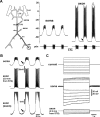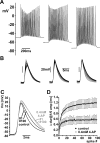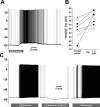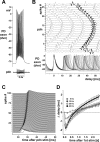Complex intrinsic membrane properties and dopamine shape spiking activity in a motor axon
- PMID: 19386902
- PMCID: PMC2743087
- DOI: 10.1523/JNEUROSCI.0716-09.2009
Complex intrinsic membrane properties and dopamine shape spiking activity in a motor axon
Abstract
We studied the peripheral motor axons of the two pyloric dilator (PD) neurons of the stomatogastric ganglion in the lobster, Homarus americanus. Intracellular recordings from the motor nerve showed both fast and slow voltage- and activity-dependent dynamics. During rhythmic bursts, the PD axons displayed changes in spike amplitude and duration. Pharmacological experiments and the voltage dependence of these phenomena suggest that inactivation of sodium and A-type potassium channels are responsible. In addition, the "resting" membrane potential was dependent on ongoing spike or burst activity, with more hyperpolarized values when activity was strong. Nerve stimulations, pharmacological block and current clamp experiments suggest that this is due to a functional antagonism between a slow after-hyperpolarization (sAHP) and inward rectification through hyperpolarization-activated current (IH). Dopamine application resulted in modest depolarization and "ectopic" peripheral spike initiation in the absence of centrally generated activity. This effect was blocked by CsCl and ZD7288, consistent with a role of IH. High frequency nerve stimulation inhibited peripheral spike initiation for several seconds, presumably due to the sAHP. Both during normal bursting activity and antidromic nerve stimulation, the conduction delay over the length of the peripheral nerve changed in a complex manner. This suggests that axonal membrane dynamics can have a substantial effect on the temporal fidelity of spike patterns propagated from a spike initiation site to a synaptic target, and that neuromodulators can influence the extent to which spike patterns are modified.
Figures











Similar articles
-
Dopamine modulation of Ih improves temporal fidelity of spike propagation in an unmyelinated axon.J Neurosci. 2012 Apr 11;32(15):5106-19. doi: 10.1523/JNEUROSCI.6320-11.2012. J Neurosci. 2012. PMID: 22496556 Free PMC article.
-
Mutual Suppression of Proximal and Distal Axonal Spike Initiation Determines the Output Patterns of a Motor Neuron.Front Cell Neurosci. 2019 Oct 23;13:477. doi: 10.3389/fncel.2019.00477. eCollection 2019. Front Cell Neurosci. 2019. PMID: 31708748 Free PMC article.
-
Dopamine modulation of two subthreshold currents produces phase shifts in activity of an identified motoneuron.J Neurophysiol. 1995 Oct;74(4):1404-20. doi: 10.1152/jn.1995.74.4.1404. J Neurophysiol. 1995. PMID: 8989381
-
Dopamine modulates two potassium currents and inhibits the intrinsic firing properties of an identified motor neuron in a central pattern generator network.J Neurophysiol. 1999 Jan;81(1):29-38. doi: 10.1152/jn.1999.81.1.29. J Neurophysiol. 1999. PMID: 9914264
-
Beyond faithful conduction: short-term dynamics, neuromodulation, and long-term regulation of spike propagation in the axon.Prog Neurobiol. 2011 Sep 1;94(4):307-46. doi: 10.1016/j.pneurobio.2011.06.001. Epub 2011 Jun 17. Prog Neurobiol. 2011. PMID: 21708220 Free PMC article. Review.
Cited by
-
Removal of default state-associated inhibition during repetition priming improves response articulation.J Neurosci. 2012 Dec 5;32(49):17740-52. doi: 10.1523/JNEUROSCI.4137-12.2012. J Neurosci. 2012. PMID: 23223294 Free PMC article.
-
Localization and function of Ih channels in a small neural network.J Neurophysiol. 2011 Jul;106(1):44-58. doi: 10.1152/jn.00897.2010. Epub 2011 Apr 13. J Neurophysiol. 2011. PMID: 21490285 Free PMC article.
-
Molecular characterization of putative neuropeptide, amine, diffusible gas and small molecule transmitter biosynthetic enzymes in the eyestalk ganglia of the American lobster, Homarus americanus.Invert Neurosci. 2018 Oct 1;18(4):12. doi: 10.1007/s10158-018-0216-4. Invert Neurosci. 2018. PMID: 30276482 Free PMC article.
-
Ionic mechanisms underlying history-dependence of conduction delay in an unmyelinated axon.Elife. 2017 Jul 10;6:e25382. doi: 10.7554/eLife.25382. Elife. 2017. PMID: 28691900 Free PMC article.
-
Temperature-robust activity patterns arise from coordinated axonal Sodium channel properties.PLoS Comput Biol. 2020 Jul 27;16(7):e1008057. doi: 10.1371/journal.pcbi.1008057. eCollection 2020 Jul. PLoS Comput Biol. 2020. PMID: 32716930 Free PMC article.
References
Publication types
MeSH terms
Substances
Grants and funding
LinkOut - more resources
Full Text Sources
